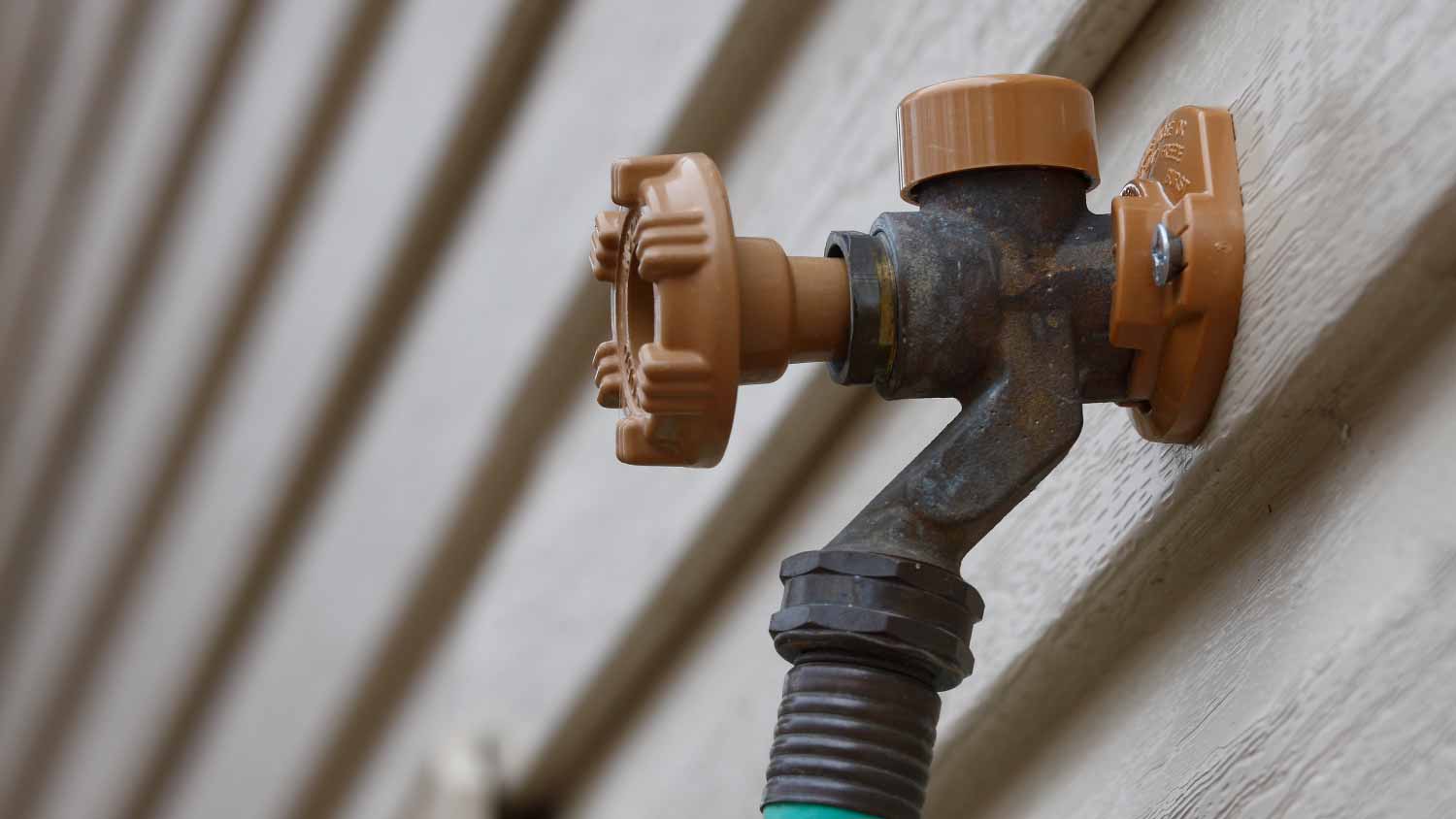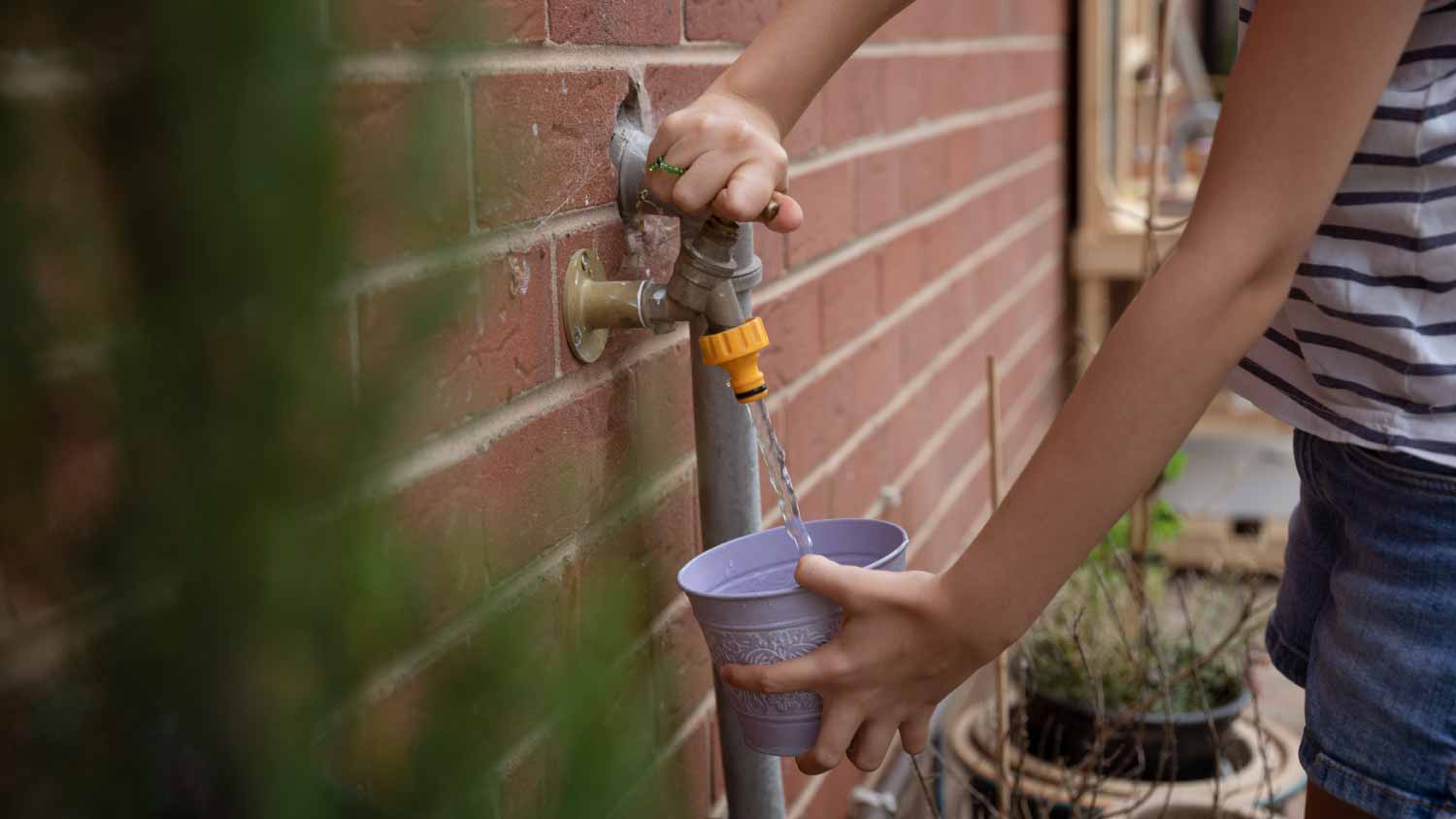
New York plumbers are some of the priciest in the nation. High cost of living and aging buildings contribute to their hefty price tag. Learn the other factors affecting how much a plumber costs in New York City.
The fix just might be a ten-cent rubber washer


Faulty washers are the most common cause of noisy outdoor faucets.
Replacing a washer or greasing a faucet handle costs less than $10.
Installing a new valve or faucet can add $100 to $500 to your costs.
Fixing a noisy outdoor faucet is usually simple and inexpensive.
If you need professional assistance, enlist the help of a plumber near you.
The day is warm, the sun is shining, your flowers are blooming, and the vibes are good—but a squeaky spigot is guaranteed to ruin it. If your outdoor faucet makes a noise when it’s turned on, the cause is often a faulty washer, which is an inexpensive and simple part to replace. But be aware: A noisy outdoor faucet could also be the result of a squeaky handle, broken valve, excessive water pressure, or loose fixtures, which could increase the expense and complexity of the repair.
Here’s how to figure out what’s causing your noisy outdoor faucet and how to fix it.

Turn on the outdoor faucet and listen carefully. Do you hear a whining or whistling noise? It might be due to a worn-out washer.
Washers are the little rubber discs that help your faucet form a tight seal. Although washers are durable, they don’t last forever. A worn-out washer can cause loud vibrating noises as water speeds past the deteriorating rubber and may lead to leaks.
Replacing a washer is a simple, inexpensive fix, using common tools and parts you can find at your local hardware store.
Is there a squeaking sound coming from the tap when you open the outdoor faucet? A squeaky handle could be the source of the sound you hear, due to hard water buildup, rust, or corrosion causing friction on the threads when the handle is turned.
Fortunately, fixing a squeaky faucet handle usually just requires a touch of plumber’s grease to lubricate the turn.
When there’s excess play in a valve, you may hear noises. If your faucet is equipped with a backflow preventer, vacuum breaker, or anti-siphon valve (a special type of backflow preventer), it could be causing the sounds you hear. Pressure-reducing valves can also cause noises in an outdoor faucet.
The valve that is the culprit in your noisy outdoor faucet may be integral to the hose bib (such as with a frost-free faucet) or inside the home. Listen for a thumping or humming sound and look for vibrations on various valve assemblies connected to the outdoor faucet to pinpoint the problem.
Fixing a faulty valve could be as simple as turning it all the way open or replacing or repairing the entire valve assembly. A sprinkler system that won’t turn off could indicate valve problems. Just as with troubleshooting a sprinkler system, you’ll need to look closely at each component to detect whether there are leaks or broken parts.
Water pipes making noise when you turn the outdoor faucet on could be the result of loose fasteners, such as pipe straps. When water rushes through the pipes, it can cause them to bang against straps or other pipes, and that can cause a loud clanging-type sound.
Fixing noise caused by loose fasteners requires a screwdriver and a few minutes time to tighten the fixtures.
Loud humming or vibrating sounds could be a sign of high water pressure in your house. Typically, homes should have water pressure between 45 and 80 psi. Pressure that’s higher than that can take a toll on your pipes and faucet and cause a lot of noise.
Test the water pressure with a pressure gauge and install a pressure regulating valve if necessary. If you already have a pressure regulator and it’s malfunctioning, it could require a repair or replacement.

Once you’ve identified where the sound is coming from and what is causing it, you can prepare to fix it.
Before you begin, remove the hose from the spigot and shut off the water. There may be a shut-off valve on your outdoor faucet (especially if you have a frost-free faucet), or you may need to find the main shut-off valve inside the house. Shutting off the water will prevent sprays, drips, and leaks from interfering with your repair efforts.
Depending on the hose bib type, you’ll likely need some common plumbing supplies to conduct the repair:
An adjustable wrench
Phillips screwdriver
Flat-head screwdriver
Plumber’s grease
Rags
Use a wrench to remove the retaining nut attached to the sillcock. This will allow you to slide the stem and handle out of the faucet. Using the appropriate screwdriver, unfasten the screw holding the washer in place and replace the washer with a new one of the same size. Then, reassemble the faucet and tighten the fittings and connections. A variety pack of faucet washers will cost you less than $10.
For a faucet handle that squeaks when you open it, you’ll need to lubricate it. Remove the faucet handle to access the threads, then apply the plumber’s grease before reinstalling the handle. You can buy a tube of plumber’s grease for under $5.
For loose pipes that slam and bang when you turn the outdoor faucet on, grab a screwdriver and look for pipe clamps, straps, or fasteners that have become loose. Use the screwdriver to tighten the screws. You can apply a few drops of a threadlocker to ensure each screw stays firmly fastened. Threadlocker is a type of adhesive for fasteners that are subject to a lot of vibration (as pipe clamps can be). You can find it at a hardware store or online.
For this fix, you’ll need to turn the water on so you can test for vibration. Ensure the valve is fully open; that may be all you need for non-ball valves to get the water running quietly again. (Just ensure you turn the water back off before winter so you don’t have to worry about an outside water spigot burst due to freezing temperatures.)
However, if the valve is broken, you’ll need to replace it. For instance, older backflow preventer valves with a spring-loaded assembly may need to be replaced with a newer type that does not have a spring. A hose bib vacuum breaker will run you under $10 or $15. A check valve or double check valve can cost $20 to $150. If you need an all-new pressure vacuum breaker, it can cost up to $300. If there’s little or no water coming out of your outside spigot, that could indicate a valve problem.
A local plumber can help you identify the type of valve you have and replace it for you, too. Depending on where you live, some valves and components may be required by code. You can ask a plumber near you for assistance if that’s the case.
It could be that it’s simply time for an all-new outdoor faucet or hose bib. Replacing an outdoor faucet can cost between $100 and $500. If you live in a cold climate, it’s worth spending a little more to get a frost-free faucet to fix your current noise issues and protect your outdoor faucet from freezing weather.
Fleetwell Air Conditioning Heating & Plumbing delivered an outstanding service experience. Their technicians were prompt, courteous, and highly professional, addressing my concerns and explaining everything clearly. They efficiently fixed my AC issues, resulting in lower energy bills. The...
Quality plumbing work!!! Very responsive and transparent about all costs up front. Overall I was very satisfied with his professionalism and quality of work!!!
On a scale of one to Mario, their plumbing skillz were a Luigi.
Tim Cubukcu who is the owner of the PC Plumbing quoted two separated jobs. One is in basement for $2,200 and another one is in closet on the first floor for $1,800. Total of $4,000. But, other plumbers only quoted around $3,000 for the exactly same work. I called Tim to cancel the work with...
They were extremely prompt in replying to my inquiry. There was some lateness regarding the arrival time; however, it was during a cold spell when there were many plumbing emergencies.
Stan called me back promptly and told me that he can't effectively service the area my building is located in. Never worked with him but at least he got back to me promptly and seemed professionally. Can't comment on his plumbing skills though.
From average costs to expert advice, get all the answers you need to get your job done.

New York plumbers are some of the priciest in the nation. High cost of living and aging buildings contribute to their hefty price tag. Learn the other factors affecting how much a plumber costs in New York City.

Discover the primary factors that affect your main water line replacement cost in New York, including length, materials, and the necessary installation method.

Discover the pricing factors that will affect your main water line repair cost in New York, including the repair type, size, and accessibility challenges.

P-traps come in various sizes for different types of drains around your home. This guide will show you what size P-trap to use for a bathroom sink.

If your toilet is leaking at the base, it can be a cause for concern. So grab some towels to stop the flow and explore these six common culprits for a leaky base.

Constant dripping and a stiff shower handle can be the first (but not last) signs of a bad shower cartridge. Learn other signs and how to fix the issue.